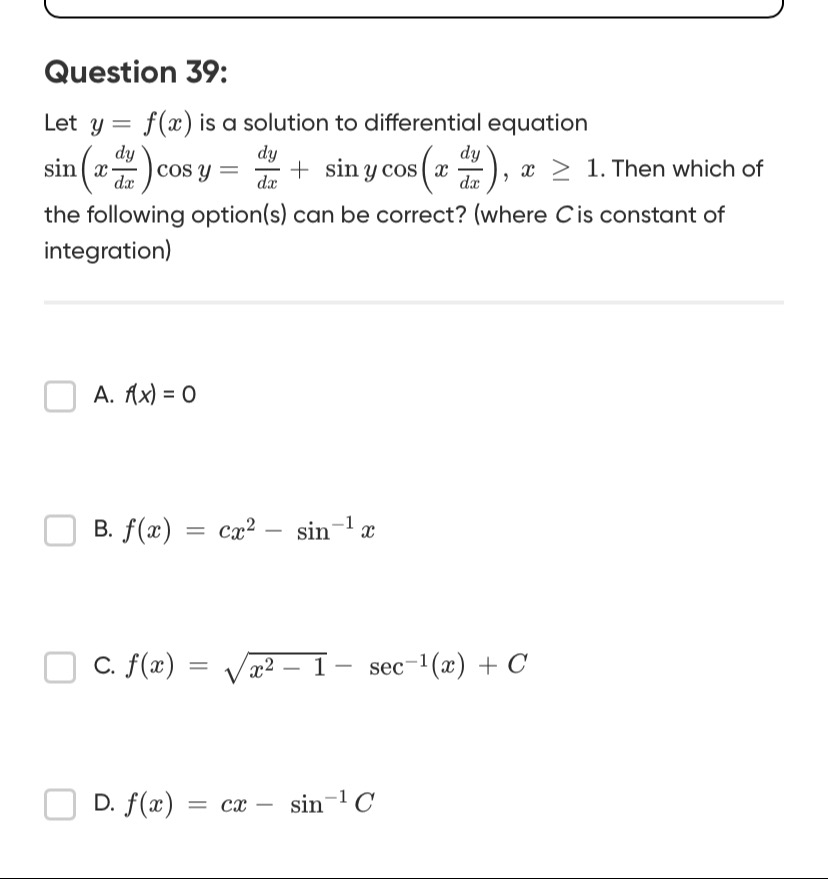Question
Question: Let $y = f(x)$ is a solution to differential equation $\sin(x\frac{dy}{dx})\cos y = \frac{dy}{dx} + ...
Let y=f(x) is a solution to differential equation sin(xdxdy)cosy=dxdy+sinycos(xdxdy),x≥1. Then which of the following option(s) can be correct? (where C is constant of integration)

f(x) = 0
f(x) = cx^2 - \sin^{-1}x
f(x) = \sqrt{x^2 - 1} - \sec^{-1}(x) + C
f(x) = cx - \sin^{-1}C
A, C, D
Solution
The given differential equation is sin(xdxdy)cosy=dxdy+sinycos(xdxdy).
Rearranging the terms, we get: sin(xdxdy)cosy−sinycos(xdxdy)=dxdy
Using the trigonometric identity sin(A−B)=sinAcosB−cosAsinB, with A=xdxdy and B=y, we have: sin(xdxdy−y)=dxdy
This is a differential equation of the form dxdy=f(xdxdy−y). Let z=xdxdy−y. Then dxdz=dxd(xdxdy−y)=(1⋅dxdy+xdx2d2y)−dxdy=xdx2d2y.
The equation becomes sin(z)=dxdy. Substitute dxdy=sin(z) into the definition of z: z=xsin(z)−y Rearranging for y: y=xsin(z)−z
Now, differentiate this expression for y with respect to x: dxdy=dxd(xsin(z)−z) dxdy=(1⋅sin(z)+xcos(z)dxdz)−dxdz
Since dxdy=sin(z), we have: sin(z)=sin(z)+xcos(z)dxdz−dxdz 0=(xcos(z)−1)dxdz
This equation implies either dxdz=0 or xcos(z)−1=0.
Case 1: dxdz=0 This means z is a constant. Let z=α. Then dxdy=sin(α). Substituting z=α and dxdy=sin(α) into y=xsin(z)−z: y=xsin(α)−α Let c=sin(α). Since −1≤sin(α)≤1, c must be in [−1,1]. Then α=sin−1(c) (using the principal value). So, y=cx−sin−1(c). This matches Option D. This solution is valid for any constant c such that −1≤c≤1.
Case 2: xcos(z)−1=0 This implies cos(z)=x1. For x≥1, we can write z=±cos−1(x1). Also, dxdy=sin(z). If cos(z)=x1, then sin(z)=±1−cos2(z)=±1−x21=±xx2−1.
Let's check Option A: f(x)=0. If y=0, then dxdy=0. Substituting into the original equation: sin(x⋅0)cos(0)=0+sin(0)cos(x⋅0)⟹sin(0)⋅1=0+0⋅1⟹0=0. So, y=0 is a solution. This corresponds to Option D with c=0.
Let's check Option C: f(x)=x2−1−sec−1(x)+C. Let y=x2−1−sec−1(x)+C. Then dxdy=x2−1x−xx2−11=xx2−1x2−1=xx2−1. Let's evaluate z=xdxdy−y: z=x(xx2−1)−(x2−1−sec−1(x)+C) z=x2−1−x2−1+sec−1(x)−C z=sec−1(x)−C.
We need to check if this is consistent with Case 2, where cos(z)=x1. We know sec−1(x)=cos−1(x1) for x≥1. So, z=cos−1(x1)−C. For this to satisfy cos(z)=x1, we must have cos(cos−1(x1)−C)=x1. Let θ=cos−1(x1). Then cos(θ−C)=cos(θ). This implies θ−C=θ+2kπ or θ−C=−θ+2kπ for some integer k. If θ−C=θ+2kπ, then C=−2kπ. If C is a multiple of 2π, this holds. If θ−C=−θ+2kπ, then C=2θ−2kπ=2cos−1(x1)−2kπ. This means C depends on x, which is not allowed for a constant of integration.
However, the question asks which option can be correct. If we choose C=0 in Option C, then z=sec−1(x). Then cos(z)=cos(sec−1(x))=cos(cos−1(x1))=x1. And dxdy=xx2−1. We need to check if dxdy=sin(z). sin(z)=sin(sec−1(x)). Let θ=sec−1(x). Then secθ=x. For x≥1, 0≤θ<π/2. sinθ=1−cos2θ=1−x21=xx2−1. So, dxdy=sin(z) holds. Thus, y=x2−1−sec−1(x) (Option C with C=0) is a valid solution.
Let's check Option B: f(x)=cx2−sin−1x. The term sin−1x is defined for −1≤x≤1. The question states x≥1. For x>1, sin−1x is not defined. Thus, Option B cannot be a solution.
Therefore, Options A, C, and D can be correct.
